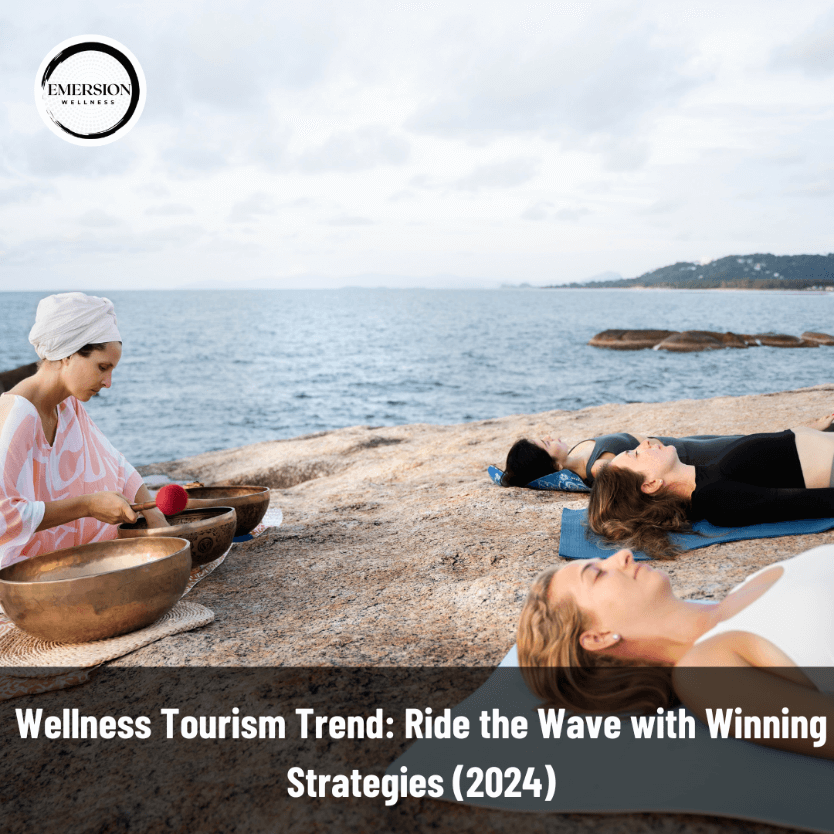In recent years, the hospitality industry has witnessed a significant shift towards wellness tourism. As a hotel revenue-generating specialist, I've closely monitored this trend and identified key strategies that hotels can implement to capitalize on the growing demand for wellness experiences. In this comprehensive guide, we'll explore the latest wellness tourism trends, provide actionable insights, and share real-life examples to help hotels maximize revenue in this expanding market.
Critical Takeaways:
- Cater to the growing demand for wellness tourism: Modern travelers are increasingly seeking holidays that promote physical and mental well-being. Embrace this trend by offering unique wellness experiences and amenities.
- Develop a distinct wellness niche: Differentiate yourself from competitors by specializing in a specific area of wellness, such as mindfulness retreats, detox programs, or adventure wellness experiences.
- Partner with local wellness providers: Collaborate with local yoga studios, spas, and wellness experts to create curated wellness packages for your guests.
Wellness Tourism Trends
Wellness tourism refers to travel experiences that prioritize health and well-being, encompassing activities such as spa retreats, fitness vacations, mindfulness retreats, and holistic wellness programs. With an increasing emphasis on self-care and holistic living, wellness tourism has emerged as a lucrative market segment within the broader travel industry.
Understanding the Growth of Wellness Tourism
The rise of wellness tourism can be attributed to several factors, including an aging population seeking rejuvenation, heightened awareness of the importance of mental and physical well-being, and a desire for authentic, immersive travel experiences. According to the Global Wellness Institute, the wellness tourism market was valued at $639 billion in 2017 and is projected to reach $919 billion by 2022.
Example: The Miraval Arizona Resort & Spa saw a 30% increase in bookings after introducing wellness-focused programs and amenities, catering to the growing demand for holistic travel experiences.
Wellness Tourism Trend: Key Drivers of Wellness Tourism
Several key drivers are fueling the growth of wellness tourism, including the rise of wellness influencers on social media platforms, increased consumer awareness of health and sustainability issues, and a growing preference for experiential travel over material possessions. Additionally, the COVID-19 pandemic has accelerated the demand for wellness-focused travel experiences as travelers seek destinations that prioritize health and safety.
Example: The Six Senses Hotels Resorts Spas experienced a surge in bookings for their wellness retreats following the pandemic, with travelers prioritizing destinations that offer secluded, nature-based experiences conducive to relaxation and rejuvenation.
Market Segmentation in Wellness Tourism
Wellness tourism encompasses a diverse range of offerings, catering to various traveler preferences and interests. From luxury spa resorts to eco-friendly wellness retreats, hotels have the opportunity to differentiate themselves by targeting specific market segments within the wellness tourism industry.
Example: The COMO Shambhala Estate in Bali appeals to wellness-conscious travelers seeking holistic wellness experiences, offering customized wellness programs, healthy cuisine, and immersive cultural activities.

Wellness Tourism Trend: Embracing Wellness Tourism - Strategies for Hotels
Enhancing Wellness Amenities and Facilities
To attract wellness-minded travelers, hotels should invest in enhancing their wellness amenities and facilities. This may include state-of-the-art spa facilities, fitness centers, yoga studios, meditation gardens, and healthy dining options. By offering comprehensive wellness amenities, hotels can position themselves as premier destinations for holistic travel experiences.
Example: The Canyon Ranch wellness resorts offer an extensive range of wellness amenities, including spa treatments, fitness classes, nutrition counseling, and mindfulness workshops, catering to the diverse needs of wellness travelers.
Wellness Tourism Trend: Curating Wellness Experiences and Packages
In addition to traditional accommodation offerings, hotels can differentiate themselves by curating bespoke wellness experiences and packages. This may involve partnering with wellness experts, organizing wellness retreats and workshops, and offering specialized wellness programs tailored to guests' needs. By providing unique, transformative experiences, hotels can attract discerning travelers seeking immersive wellness experiences.
Example: The Chiva-Som International Health Resort in Thailand offers personalized wellness retreats focused on holistic healing, mindfulness, and sustainable living, providing guests with a transformative wellness journey.
Integrating Technology for Wellness Services
Technology plays a crucial role in enhancing the delivery of wellness services and personalized experiences. Hotels can leverage technology solutions such as wellness apps, wearable devices, virtual reality meditation sessions, and online wellness consultations to engage guests and facilitate their wellness journey. By embracing innovative technology solutions, hotels can elevate the guest experience and differentiate themselves in the competitive wellness tourism market.
Example: The Four Seasons Hotels & Resorts launched the Four Seasons App, which provides guests with access to virtual fitness classes, guided meditation sessions, and personalized wellness recommendations, enhancing the overall guest experience.
Wellness Tourism Trend: Emphasizing Sustainability and Environmental Stewardship
In today's environmentally conscious landscape, sustainability has become a key consideration for wellness travelers. Hotels can demonstrate their commitment to sustainability by implementing eco-friendly practices such as energy conservation, waste reduction, water conservation, and sourcing local, organic ingredients for their wellness offerings. By prioritizing sustainability, hotels can appeal to eco-conscious travelers and align with their values.
Example: The Singita wellness lodges in Africa incorporate sustainable design principles, renewable energy sources, and conservation initiatives, providing guests with a sustainable, eco-friendly wellness experience amidst pristine natural surroundings.
Conclusion: Wellness Tourism Trend
As the demand for wellness tourism continues to rise, hotels have a unique opportunity to capitalize on this trend and maximize revenue by offering authentic, transformative wellness experiences. By enhancing wellness amenities, curating bespoke wellness packages, integrating technology solutions, and prioritizing sustainability, hotels can attract wellness-minded travelers and differentiate themselves in the competitive hospitality landscape.
At Emersion Wellness, we specialize in helping hotels leverage wellness tourism trends to increase revenue and enhance guest satisfaction. Contact us today to learn more about our innovative revenue-generating ideas and comprehensive wellness programs. Whether you're looking to increase room bookings, spa visits, or food and beverage sales, our team of experts is here to support your success in the booming wellness tourism market.
Frequently Asked Questions: Wellness Tourism Trend
- What exactly is wellness tourism, and how does it differ from traditional tourism? Wellness tourism focuses on promoting health and well-being during travel, offering activities and experiences aimed at rejuvenation and relaxation. Unlike traditional tourism, which may prioritize sightseeing or leisure activities, wellness tourism emphasizes holistic wellness and self-care.
- What are some common types of wellness tourism experiences available to travelers? Wellness tourism experiences can vary widely and may include spa retreats, yoga and meditation retreats, fitness vacations, mindfulness workshops, holistic wellness programs, and eco-friendly wellness retreats. These experiences cater to diverse preferences and interests within the wellness tourism market.
- What are the key factors driving the growth of wellness tourism globally? Several factors contribute to the growth of wellness tourism, including increased awareness of health and well-being, rising stress levels, an aging population seeking rejuvenation, and a desire for authentic, meaningful travel experiences. Additionally, the COVID-19 pandemic has underscored the importance of wellness and safety in travel.
- How can hotels capitalize on the wellness tourism trend to attract more guests and increase revenue? Hotels can capitalize on the wellness tourism trend by enhancing their wellness amenities and facilities, curating bespoke wellness experiences and packages, integrating technology for wellness services, and emphasizing sustainability and environmental stewardship. These strategies help hotels attract wellness-minded travelers and differentiate themselves in the market.
- What role does technology play in enhancing the wellness tourism experience for travelers? Technology plays a crucial role in enhancing the wellness tourism experience by providing access to virtual fitness classes, meditation apps, wellness tracking devices, online wellness consultations, and immersive wellness experiences. These technological innovations enhance convenience, personalization, and engagement for wellness travelers.
- How can hotels ensure that their wellness offerings align with sustainability principles? Hotels can ensure that their wellness offerings align with sustainability principles by implementing eco-friendly practices such as energy conservation, waste reduction, water conservation, sustainable sourcing, and community engagement initiatives. Prioritizing sustainability helps hotels minimize their environmental footprint and appeal to eco-conscious travelers.
- What are some emerging trends in wellness tourism that hotels should be aware of? Emerging trends in wellness tourism include the rise of wellness-focused travel apps and platforms, the integration of wellness into remote work and digital nomadism, the growing popularity of wellness sabbaticals and extended retreats, and the emergence of wellness-focused travel corridors and destinations.
- How can hotels effectively market their wellness offerings to attract wellness-minded travelers? Hotels can effectively market their wellness offerings by leveraging digital marketing channels such as social media, influencer partnerships, content marketing, and search engine optimization (SEO). Engaging storytelling, visually appealing content, and targeted advertising campaigns can help hotels reach and resonate with their target audience.
- What are some potential challenges that hotels may face in implementing wellness tourism initiatives? Some potential challenges that hotels may face in implementing wellness tourism initiatives include high initial investment costs for wellness amenities and facilities, maintaining consistent quality and standards across wellness offerings, managing guest expectations, and navigating regulatory compliance in the wellness industry.
- How can hotels measure the success and impact of their wellness tourism initiatives? Hotels can measure the success and impact of their wellness tourism initiatives by tracking key performance indicators (KPIs) such as occupancy rates, revenue per available room (RevPAR), guest satisfaction scores, repeat bookings, and social media engagement metrics. Regular performance monitoring and guest feedback analysis help hotels evaluate the effectiveness of their wellness offerings and make data-driven decisions for continuous improvement.
Also, see Maximize Hotel Revenue by 25% with Effective Hotel Inventory Management Strategies

I'm Nathan Baws, a nutrition nerd, exercise and weight loss expert, and an unwavering advocate for good health. As the founder of Emersion Wellness, I'm passionate about crafting Seamless Weight Loss Programs to supercharge hotel revenue and transform lives. We've pioneered the World's First Plug & Play Weight Loss Programs for top hotels and resorts, sparking a wellness revolution. Beyond my professional journey, you'll often find me hiking, swimming, and riding the waves, embracing every moment in nature. Join me on this exhilarating journey towards diet, health and wellness.

